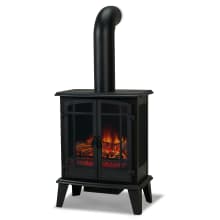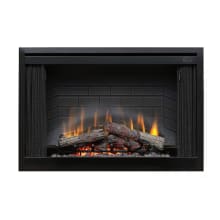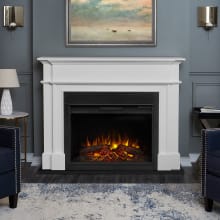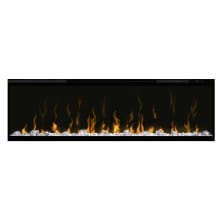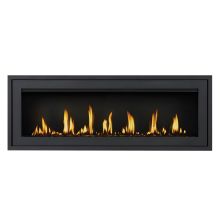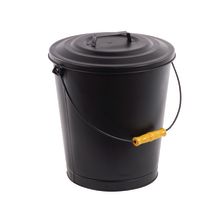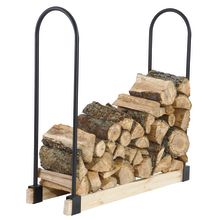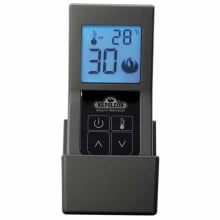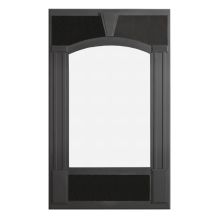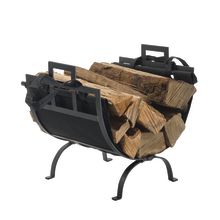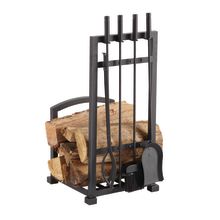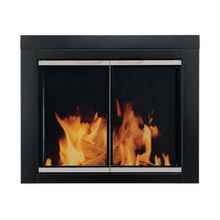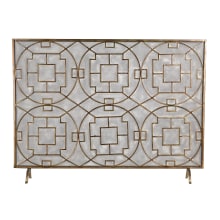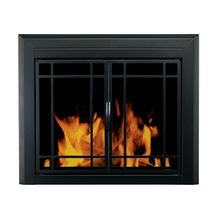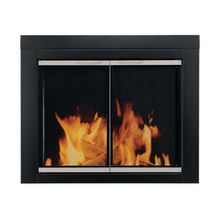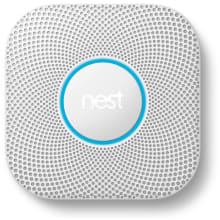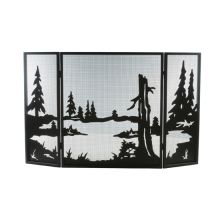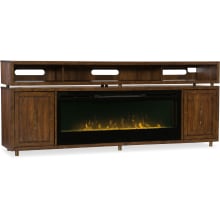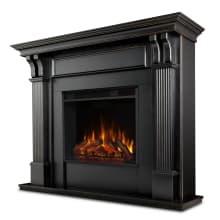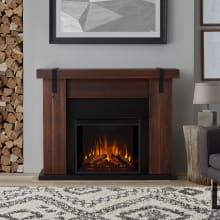Fireplace Buying Guide
Get to know the different types of fireplaces to find the best addition to your space.
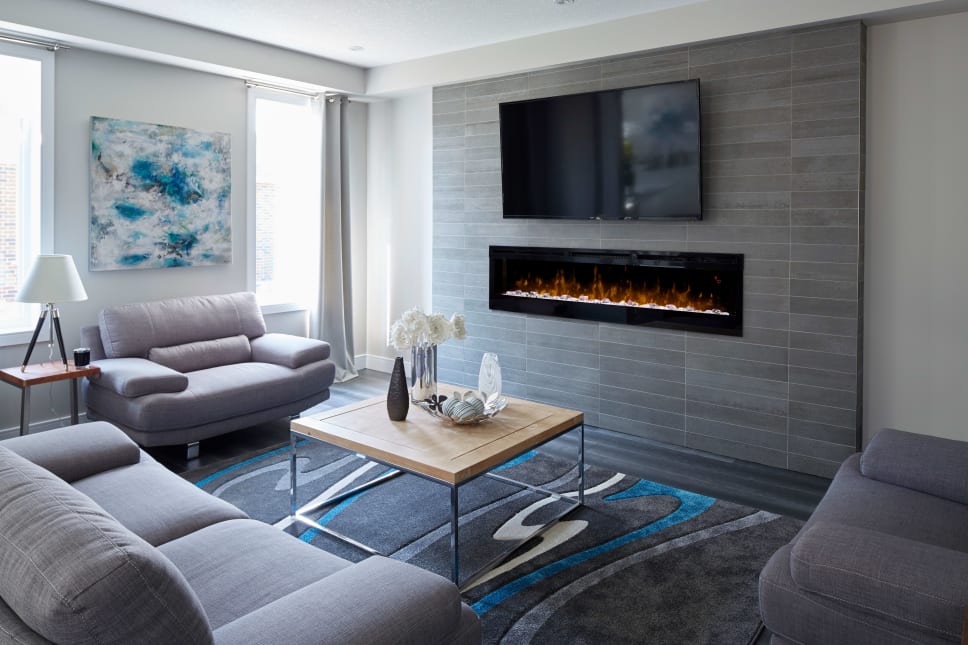
There’s nothing quite like the feeling of warming yourself by the fire while enjoying a hot cup of coffee or tea. Inside and outside your home, fireplaces can provide a stylish focal point that doubles as a functional way to warm up the room in those colder winter months. Incorporate this classic heating element in your home is easy with the help of this buying guide, which breaks down the different types of fireplaces, how to choose the right fuel type for your space, and final considerations for selecting the best one for your home.
Anatomy of a Built-In Fireplace
A fireplace is a commanding feature in any space. They may seem simple and straight forward, but between their size and their functional purpose, there are a few important pieces to take note of before you plan them into your home, office, or work spaces.
- Fire Box: The fire box is the large interior area where you build the fire.
- Mantel: This is the decorative ledge often featured above the fireplace and can be made of wood, stone or other heat-safe materials. The mantel is often used as a place to showcase decorative accents, such as framed artwork or candlesticks.
- Chimney: The vertical channel that directs smoke up from your firebox and out through your roof or another exit point in your home.
- Hearth: The hearth is the very base of the fireplace, often extending well past the fire box into the room. They are typically made of brick, stone, metal or tile depending on the type of fireplace you have. Many gas and electric fireplaces do not have or require a hearth.
Types of Fireplaces
Once you’ve decided to add a little ambiance to your room with the addition of a fireplace, it’s time to determine which of the four fireplace styles is best suited to your space.

Built-In Fireplace
Fireplaces that are recessed into the wall are called built-in fireplaces. This can encompass wood burning, electric, and gas options. Traditional wood-burning fireplaces require chimneys and vents, which can make them one of the more involved installations, requiring a licensed contractor in many cases.
When you want the look of a built-in fireplace without the effort of professional installation and possibly the addition of a chimney, fireplace inserts make the next best option. Like a built-in fireplace, they nestle into the wall. They fit into your existing hearth or a new space you create and come in a variety of fuel types but don’t require a chimney.

Mantel Fireplace
When you want a fireplace in your space but you don’t want to alter the architecture of your home, mantel fireplaces make a fantastic option. This freestanding fireplace is built with a wood mantel surrounding the design and is easy to set in place and start using in a matter of minutes. Just push it up against the wall like you would a credenza or other large piece of furniture, plug it in, and you’re ready to go. Mantel fireplaces are a great choice for renters or anyone who moves frequently because they can be taken along with you.

Wall Mount Fireplace
Hang a fireplace on your wall without a big remodeling project with gas or electric wall mount fireplaces. These fireplaces mount directly to the wall but don’t require vents and chimneys to be installed. This type of fireplace is available in electric, natural gas, and liquid propane fuel options for your convenience.

Media Console Fireplace
You don’t have to decide between displaying a television and a fireplace when you choose a media console fireplace with a fully integrated design. These units begin with a beautiful piece of furniture designed to nestle under a tabletop or wall-mounted television. In the console itself is an electric fireplace. These units come in a wide range of sizes, finishes, and styles. Most even include additional storage and display space, allowing you to showcase gaming systems, books, cable boxes, and more.
Stove Fireplace
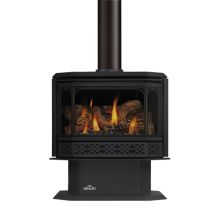
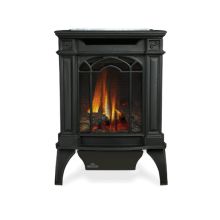
Often used in cabins as a source of heat on a cold day, stove fireplaces provide an industrial look with timeless appeal. Most wood stoves or pellet stoves feature a direct vent design so smoke doesn’t accumulate in the room. When you want the look without the work of adding a direct vent, choose one of the more modern vent-free stove fireplaces.
Log Sets
When you have an old, built-in fireplace that isn’t operational anymore, such as in a historic home, you can get the look of a raging fire without taking on an expensive fireplace remodel by placing log sets in the existing fireplace. These simple, self-contained units provide the look of logs piled on a grate but are fueled with electricity or gas. Often, log sets even come with a remote control for convenience.
Fuel Types
There are three different fuel types to consider as you shop for the best fireplace to feature on your accent walls. When you’re looking for traditional authenticity with maximum ambiance, a wood fireplace is clearly the way to go. Unfortunately, it can take some time to light a wood fireplace and then to allow the fire to burn down. When you want ultimate convenience, electric and gas fireplaces make a great alternative because they can turn on and off in a matter of seconds.

Wood Fireplace
That crackling fire sound you associate with a fireplace comes from wood as it burns. A wood fireplace is the most classic of all fireplace types, going back to the earliest forms of the piece. Because wood is a natural material that produces smoke as it burns, wood fireplaces require proper venting through a chimney to avoid smoke build-up in the house. You will also need to constantly feed new logs into the fire to keep it going. After burning a fire in a wood fireplace, you’ll need to clean out the ash that accumulates at the bottom of the fireplace.

Electric Fireplaces
Electric fireplaces are designed to give you the same look as a wood-burning fireplace, but without the need to feed wood into the fireplace. Instead, you either plug these fireplaces into a nearby outlet or have them hardwired into your electrical system. With the flip of a switch, these fireplaces turn on and begin producing both beauty and warmth. Often, these fireplace have faux logs in the bottom that help to complete that wood-burning look. Unlike other logs, these faux logs do not break down as the fireplace runs.

Gas Fireplaces
Within the family of gas fireplaces are two distinct options:
- Liquid Propane: When you don’t have natural gas running into your home, a liquid propane fireplace makes a great choice. Adjusting the amount of gas that comes through the line adjusts the height of the flame. Faux logs help resemble the look of a wood fireplace but the logs don’t produce ash and smoke and don’t break down over time.
- Natural Gas: Both vented and ventless natural gas fireplaces are available. Vented natural gas fireplaces are completely sealed off, pulling air from outside for combustion. Ventless natural gas fireplaces operate much like that of a gas stove, using the air from the room for combustion and releasing heat into the space.

How to Choose the Right Fireplace for Your Home
Now that you understand the different types of fireplaces available to you, it’s time to look at the key five things that will help you choose the best wood, gas, or electric fireplace or insert to showcase in your home.
Location
Before you begin to shop, think about where you plan to feature the fireplace. Keep in mind the seating arrangement of your room, as you’ll want the fireplace to be a focal point from nearly every seat in the room. This will help you to establish where your fireplace wall accent will be.
Size
Take careful measurements of the space you have available and compare those measurements to the dimensions of the fireplace you’re considering to ensure a great fit. This is especially important with built-in fireplace designs.
Design
The overall design style of the room will help you determine what style of fireplace makes the best compliment to the existing decor. This can include the finishes, surrounds, trim work, and more. If you have a wall that is shared between a bedroom and a living area, you can even consider double-sided fireplaces. Flip through your favorite design magazines or peruse the websites of your favorite interior designers to find fireplace surround ideas that will complement the overall design style of your home.
Fuel Type
Once there are a couple fireplace designs that catch your eye, it’s time to determine which of the three fuel types best suits your lifestyle. Wood fireplaces bring an instant mood into the space while electric and gas fireplaces offer incredible convenience and ease.
Heat
One of the purposes of showcasing a fireplace in the home is to produce warmth in the cold winter months without turning on the home’s heater. As you shop for your fireplace, take note of the BTUs provided by each model. The higher the BTUs, the more warmth the fireplace provides. The average BTU output for a residential fireplace is around 5,000.
If you live in a warm climate and want a little more ambiance, one with low BTUs may be ideal. If you live in a cold climate and really want to warm up, look for a fireplace with a higher BTU output The size of the room also plays an important factor. It’s easier to warm up a small space than a large space, so more BTUs will be required for vast rooms.

Accessories & Decor
After determining which fireplace you’ll feature in your home, it’s time to complete the purchase with a couple fireplace accessories and decor items. Not only are these items functional, but they’re also styled in a way that makes them an eye-catching accent arranged around your hearth. While there are many different types of accessories offered, a few of the most common items include:
- Hearth: A raised grate for supporting natural or faux wood logs. They allow for proper airflow around the logs to feed the fire.
- Tool Set: A natural wood fire needs a little bit of tending to. Fireplace tool sets feature shovels, brooms, pokers and other tools that will help you to build a proper fire and to clean up after your fire.
- Ash Disposal Cans: Natural wood fires produce ash. Shovel that ash into a heat-safe container to make cleanup a little easier.
- Log Rack: A wood fireplace requires a steady addition of more logs. A log rack provides a decorative place to store the extras before they can be used.
- Fireplace Screens: Keep children, pets, and your furnishings away from hot embers by placing a fireplace screen, or glass fireplace doors in front of the fireplace.
- Colored Glass: Both electric and propane fireplaces can use colored glass in the stead of logs for a modern look. You can purchase replacement colored glass in a range of hues to customize the look of your fireplace to your decor.
- Replacement Parts: Keeping your fireplace running smoothly year after year is easy when you shop the selection of replacement parts available, including remote controls, extension kits, propane conversion kits, decorative surrounds, and more.

Fireplace Safety Considerations
Any time you are featuring a fire element in your home, safety needs to be a priority. When you’re trying to limit risk, electric fireplaces make a fantastic option because it’s a very controlled burn and easy to adjust the flame height.
Accessories for Fireplace Safety
Wood can create sparks as it burns. For that reason, it’s important to put fireplace screens in front of your wood-burning fireplaces. This will help to keep hot embers and burning sparks from escaping the confines of the fireplace and burning you, your furniture, or even your flooring.
Ventilation
Ventilation is a major concern when you have wood-burning fireplaces. Burning wood produces smoke and that smoke needs somewhere to go so that it doesn’t build up in the home. A chimney provides the ventilation necessary for most wood-burning fireplaces but it is important to make sure the flue is open as the fire burns.
Smoke Alarms
Every home, regardless of whether it features a fireplace or not, should have plenty of smoke alarms in place. If you have a fireplace installed in your living room or bedroom, you’ll want a smoke alarm near the entry of the room to ensure quick notification smoke builds up in the space. Never install the smoke detector on the ceiling directly above the fireplace, as it could set off the alarm unnecessarily. If you are installing new smoke alarms throughout your home, make sure to choose models that detect both smoke and carbon monoxide. For more tips on smoke alarms and the ideal placement in a home, check out our smoke alarm guide.

Outdoor Fireplaces
Incorporating modern outdoor fireplace ideas into your space is a great way to transform any deck or patio into an inviting outdoor living area. Adding a wood-burning, gas, or electric outdoor fireplace or fire pit in your outdoor living area will create an enticing and comfortable place to gather with friends and family for great conversations while extending the number of months and hours you can comfortably enjoy your outdoor space. If you don’t want to install an outdoor fireplace, consider choosing an outdoor firepit instead.

